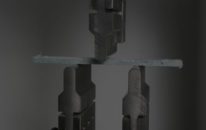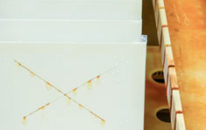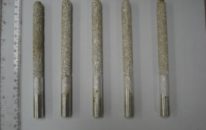Mechanical Testing
How strong is it? Will it resist wear? Is it likely to crack when being stamped? These are some of the questions that can be answered by testing the mechanical properties of your material.mechanical testing
At Paragon Systems Testing Lab, we have all the state of the art equipment required to conduct extensive mechanical testing to measure hardness, tensile strength, elongation, elasticity, and fatigue limit.
Tensile and Formability Testing
A variety of materials properties can be determined from a tensile test. The yield strength is the stress per unit area that a material can withstand before permanent deformation occurs. The ultimate tensile strength is the maximum stress per unit area that a material can withstand before rupture. Both materials properties, which are determined from a tensile test are used in design calculations as well as routine quality control.
Ductility is measured using elongation and reduction of area.
The strain hardening test (n-value) and the plastic strain ratio (r-value) are used as measures of formability and are useful measurements for deep drawing or stretch forming applications.
The existence of hydrogen embrittlement damage can be determined with a static load tensile test. This test is commonly used to verify safe plating conditions were present when plating hardened steels.
Most tensile materials properties can be determined at temperatures ranging from -70°C to 200°C.mechanical testing
Hardness Testing
We can perform all of the common indentation hardness tests for metal, plastic and rubber materials.
Both macro hardness testing techniques like Rockwell or Brinell and micro techniques like Vickers or Knoop are accurately determined with our modern digital equipment.mechanical testing
The Rockwell or Barcol hardness test method can also be used on plastic and composite materials while the Durometer method is usually employed on rubber or elastomeric materials.
Flexural Testing
Flexural materials testing is used to characterize the properties of a material loaded in bending.
Depending on the method selected, the two loading conditions are a beam in 3-point or in 4-point bending.
A variety of materials properties are defined by the flexural test methods but the two properties most commonly determined are flexural modulus and flexural strength.mechanical testing
Flexural modulus is a measure of the initial stiffness of the material in bending while flexural strength describes the ultimate stress that the material can support in bending.
Flexural materials properties can be determined at temperatures ranging from -70°C to 200°C.mechanical testing
More From Paragon Systems

CIPP Liner Testing
As the industry has matured, we have continued to add state-of-the art CIPP liner test techniques for measuring the mechanical properties of CIPP liner materials …

MonoStructure Testing
Microstructure materials testing is the science of interpretation of material structures. By sectioning, polishing and then …

Coating Performance Testing
Coatings (both paint and plating) are used to enhance a variety of properties of a substrate. Corrosion resistance, hardness …

Anode Efficiency Testing
Buried ductile iron and cast iron pipe is exposed to continual corrosive attack which eventually leads to pinhole depressions in the …

